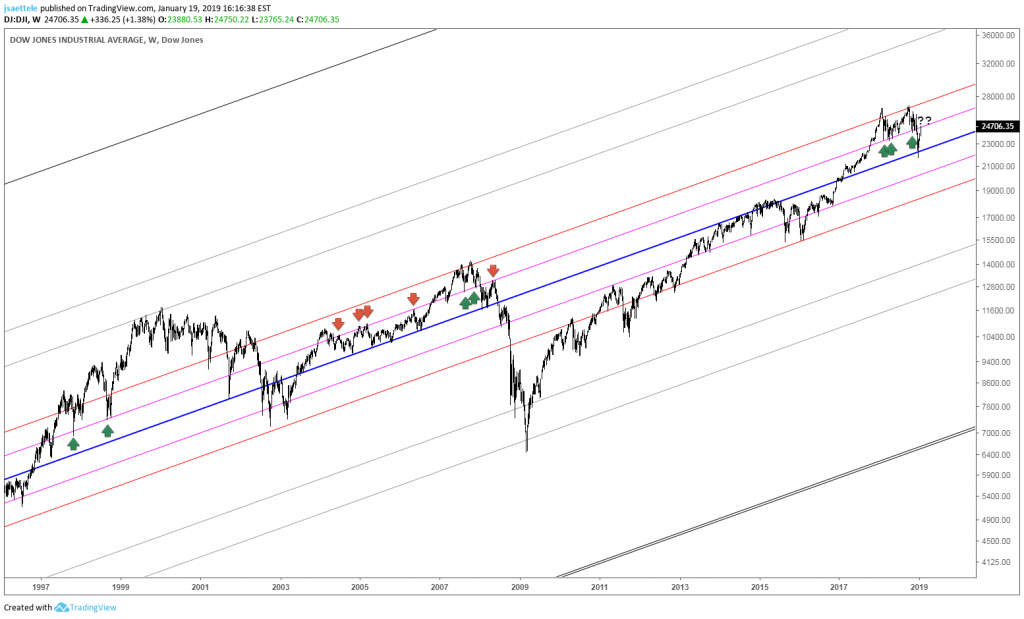In October, I warned of an important behavior change in U.S. stock markets and also identified the bond market low. Major U.S. indices have rallied 10%+ in the last 4 weeks after entering ‘bear market’ territory. So, what now? The DJIA has returned to a major long term parallel and the 10 year U.S. T-yield is a few ticks shy of old lows (charts below). I’ll go out on a limb and say that these markets are testing important barriers. Obviously, macro implications are significant. Good luck!
For original market insights and analysis of intraday, daily, weekly and monthly charts, member only webinars, Twitter updates, and trade plans, then join the SB community.
DJIA Weekly
10 Yr U.S. T-Yield Weekly
Any reviews, news, research, analysis, prices or other information contained in this article is provided as general market commentary, does not constitute investment advice and may undergo changes from time to time. Trading the Financial and Currency Markets on margin carries a high level of risk and may not be suitable for all investors. The high degree of leverage can work against you as well as to your favor. Before entering trading Financial and Currency Markets, you should carefully consider your investment objectives, level of experience and risk appetite. There is a possibility that you could sustain a loss of some or more of your initial investment and therefore you should not invest money which you cannot afford to lose. You should be aware of all the risks associated with Financial and Currency Markets trading, and in case you have any doubt, rather seek advice from an independent financial advisor. Scandinavian Capital Markets AB, its owners, employees, agents or affiliates do not give investment advice, therefore Scandinavian Capital Markets AB assumes no liability for any loss or damage, including without limitation to, any loss of profit, which may be suffered directly or indirectly from use of or reliance on such information. Scandinavian Capital Markets AB strongly encourages consultation with a licensed representative or financial advisor regarding any particular investment or use of any investment strategy.
Recommended Content
Editors’ Picks
AUD/USD jumps above 0.6500 after hot Australian CPI data

AUD/USD extended gains and recaptured 0.6500 in Asian trading, following the release of hotter-than-expected Australian inflation data. The Australian CPI rose 1% in QoQ in Q1 against 0.8% forecast, providing extra legs to the Australian Dollar upside.
USD/JPY hangs near 34-year high at 154.88 as intervention risks loom

USD/JPY is sitting at a multi-decade high of 154.88 reached on Tuesday. Traders refrain from placing fresh bets on the pair as Japan's FX intervention risks loom. Broad US Dollar weakness also caps the upside in the major. US Durable Goods data are next on tap.
Gold price cautious despite weaker US Dollar and falling US yields

Gold retreats modestly after failing to sustain gains despite fall in US Treasury yields, weaker US Dollar. XAU/USD struggles to capitalize following release of weaker-than-expected S&P Global PMIs, fueling speculation about potential Fed rate cuts.
Crypto community reacts as BRICS considers launching stablecoin for international trade settlement

BRICS is intensifying efforts to reduce its reliance on the US dollar after plans for its stablecoin effort surfaced online on Tuesday. Most people expect the stablecoin to be backed by gold, considering BRICS nations have been accumulating large holdings of the commodity.
US versus the Eurozone: Inflation divergence causes monetary desynchronization

Historically there is a very close correlation between changes in US Treasury yields and German Bund yields. This is relevant at the current juncture, considering that the recent hawkish twist in the tone of the Fed might continue to push US long-term interest rates higher and put upward pressure on bond yields in the Eurozone.

